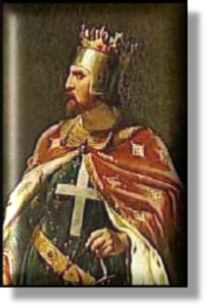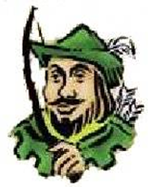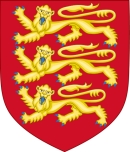


 xxxxxKnown as "the Lion-heart", Richard I is one of the
best known of English monarchs, despite the fact that he spent only
six months of his reign in England. His fame rests mainly on his
prowess on the battlefield. As a member of the Third Crusade, he
spent three years in the Holy Land where he won a number of
victories over the Muslims but failed to recapture Jerusalem. His
most significant victory proved to be his conquest of Cyprus, which
he captured during his sea voyage out to the Levant. It was while
staying at Limassol on this island that he married Berengaria of
Navarre, but there were no children by this marriage.
xxxxxKnown as "the Lion-heart", Richard I is one of the
best known of English monarchs, despite the fact that he spent only
six months of his reign in England. His fame rests mainly on his
prowess on the battlefield. As a member of the Third Crusade, he
spent three years in the Holy Land where he won a number of
victories over the Muslims but failed to recapture Jerusalem. His
most significant victory proved to be his conquest of Cyprus, which
he captured during his sea voyage out to the Levant. It was while
staying at Limassol on this island that he married Berengaria of
Navarre, but there were no children by this marriage.
xxxxxOn his return to Europe, he
spent the last five years of his life defending his empire in
France, a vast stretch of land which included Normandy, Anjou and
Aquitaine. He won a series of battles against the French king,
Philip II, including victories at Freteval and Courcelles, but in
April 1199, while laying siege to the castle of Chalus in the Duchy
of Acquitaine, he was mortally wounded by a bolt from a crossbow. He
was buried in the abbey church of Fontevrault, where his parents had
also been laid to rest.
xxxxxApart from the years spent
fighting, he was also held captive on the continent for well over
twelve months. While returning from the crusade, a storm drove his
ship ashore at Venice. He made his way across Europe in disguise,
but on reaching Vienna he was captured by the Duke of Austria, held
prisoner, and then handed over to the German Emperor, Henry VI. He
was only released after the payment of a huge ransom, the enormous
size of which provides ample proof of the growing prosperity of
England at this time.

xxxxxThe dashing figure cut by
this gallant, fighting king, - a man with the heart of a lion -
inevitably made him the hero of countless romantic legends and the
subject of many a troubadour song. Indeed, Richard was himself a
poet. And according to one legend - first contained in the
thirteenth century Narrative of the Minstrel of
Reims - a certain troubadour from northern France
named Blondel de Nesle, having discovered that Richard had been
imprisoned by the German Emperor Henry VI, played a large part in
gaining his release.
xxxxxBut in fact this
charismatic hero-king did little for England. He had but two
major aims: to take part in the Crusade and to defend and, if
possible, extend his possessions on the continent. It is true that,
before departing for the Holy Lands, he appointed the Bishop of Ely,
William Longchamp, to rule the country in his absence, but within a
few months his brother, Prince John, backed by a set of powerful
barons, was the power behind - if not on - the throne.
Thus the absence of the monarch over a number of years - close
on ten - , plus the dependence of John upon the support of the
barons, undermined the authority of the crown and sowed the seeds of
future unrest.
xxxxxIn addition, he introduced
a variety of new taxes - one called the Saladin tithe -
and put most of his personal possessions up for sale in order to
cover the cost of his overriding ambition, the recapture of the Holy
City of Jerusalem. And this burden of taxation was substantially
increased when a huge ransom had to be paid to the German Emperor,
Henry VI, to secure his safe return. A gallant and inspiring fighter
he might well have been on distant battlefields, but at home he was
not a popular monarch. Nor were matters made easier by the lack of
an heir. Richard was, in fact, a homosexual and his marriage to
Berengaria of Navarre was a marriage in name only.

xxxxxIncidentally, though the legend of Robin
Hood has never been authenticated or given
a place in time, there is a belief that this outlaw and his band of
merry men in Sherwood Forest might well have been robbing the rich
and paying the poor during the reign of Richard I. However, the
ballads about this popular hero tend to suggest that if he did
exist, then he was likely to have been around in the fourteenth
century during the agrarian discontent that culminated in the
Peasants' Revolt of 1381.
RICHARD I 1189 - 1199
(R1) Lived 1157-1199

|
1189
1192
|
 The
Third Crusade
is launched with the aim of recapturing Jerusalem for the
Christian faith. Three European kings take part, including
Richard, but national rivalry prevents a united front, and the
crusade ends in failure. The
Third Crusade
is launched with the aim of recapturing Jerusalem for the
Christian faith. Three European kings take part, including
Richard, but national rivalry prevents a united front, and the
crusade ends in failure.
Richard is captured by Duke Leopold of
Austria while crossing Europe on his way home from the crusade.
He is imprisoned and then handed over to the German king, Henry
VI. He is released on payment of a large ransom.
In Japan, the Minomoto
Clan establishes a military government in which hereditary
feudal lords known as Shoguns govern the country. This system remains in force
until 1868 (Vb).
|
|
1193
|
Sultan Muhammad
of Ghur, the founder of Islamic power in India, conquers
most of northern India. Delhi, the Muslim capital, becomes the
centre of an empire in the making.
|
|
1194
|
Richard, held captive by the Emperor Henry
VI, is only released after the payment of a huge ransom, paid in
the most part by the raising of extra taxes at home.
|
|
1196
|
In the continuing battle between Moors and
Christians for control of the Iberian peninsula, Alfonso VIII, King
of Castile, is roundly defeated by Berber forces at the Battle
of Alarcos.
|
|
1199
|
 Richard
is killed at the siege of Chalus Castle while defending his
lands in France. His brother John,
supported by a group of barons, loses no time in seizing the
English throne. Richard
is killed at the siege of Chalus Castle while defending his
lands in France. His brother John,
supported by a group of barons, loses no time in seizing the
English throne.
|
Acknowledgements
Richard I: Detail from
portrait by the French Neoclassical painter Merry-Joseph
Blondel (1781-1853), 1841 – National Museum, Versailles,
France. Coat of Arms: licensed under
Creative Commons. Author: Sodacan – https://commons.wikimedia.org.
R1-1189-1199-R1-1189-1199-R1-1189-1199-R1-1189-1199-R1-1189-1199-R1-1189-1199-R1
Incidentally, the early
history of the English royal coat of arms is
not clear-cut. What is certain is that by 1198 Richard I was
using the coat of arms illustrated above - a red shield with
three running gold lions showing the full face and arranged one above
the other. Earlier than that, the most likely explanation is that the
first lion was that of Rollo, Duke of Normandy, and the second was
that of Maine, a country that had been taken over by Normandy. The two
lions came over on William the Conqueror’s coat of arms and then the
third was added by Henry II, probably to represent his wife, Eleanor,
Duchess of Aquitaine, the mother of Richard I. Today the arms appear
on the first and fourth quadrants of the British Royal Standard, and
the three-lion logo is used widely to represent England,
especially in sport.





Timewise Traveller is a free
non-profit resource. However, if you have found it of
interest/value and would like to show your appreciation, the author
would welcome any contribution to Cancer Research UK.
To visit our Cancer Research
page and make a small donation, click 









 xxxxx
xxxxx

 The
The
 Richard
is killed at the siege of Chalus Castle while defending his
lands in France. His brother
Richard
is killed at the siege of Chalus Castle while defending his
lands in France. His brother 